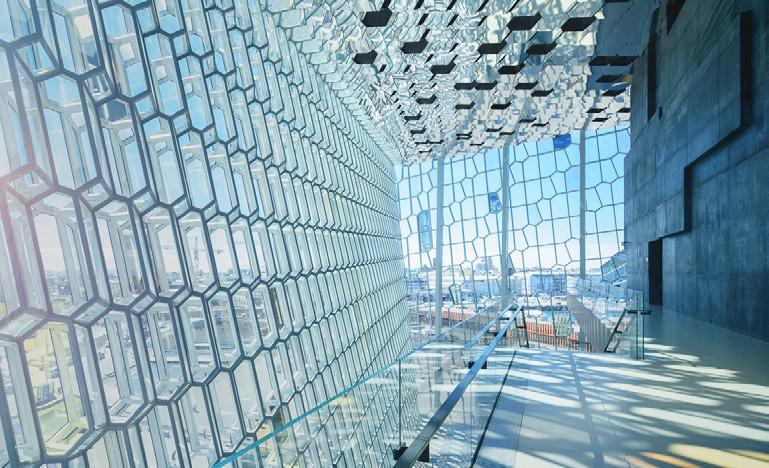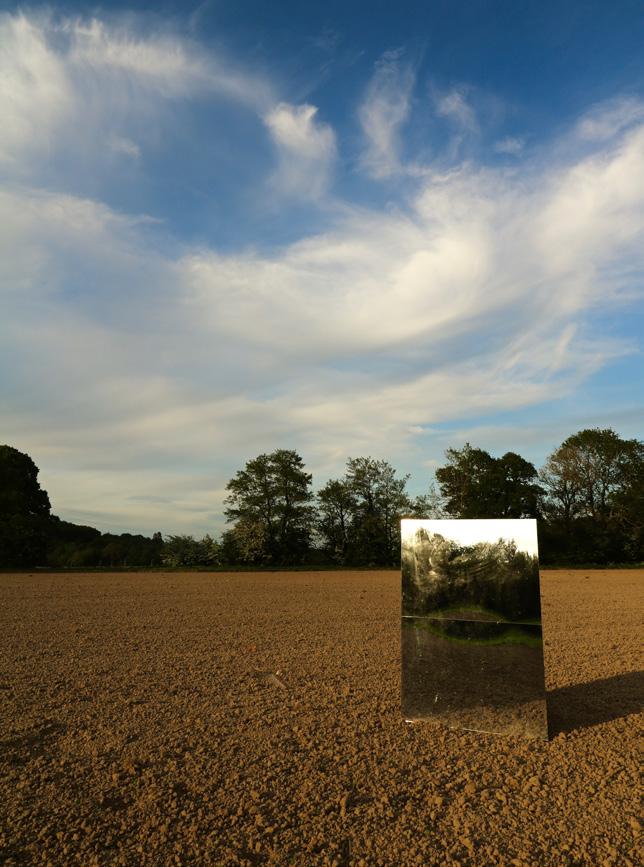
8 minute read
How Architecture Reflects Our Surroundings Habina Seo
how ARCHITECTURE reflects ourSURROUNDINGS
Habina Seo YEAR 12
Architecture is the backdrop to our lives: the walls that enclose us, the doors and arches we walk through, the churches we are married in, the theatres we go to, the train stations in which we sit every morning and evening, all involve architecture which both reflects and influences our culture. The world we live in now is largely defined by its buildings and how they mirror our cultural, social and economic surroundings and needs. An architectural identity is one of the most important factors of a nation’s culture and history, as it indicates the environment in which that culture was developed and is itself is a distinctive cultural product.
The physical functions of a building, as well as its design motifs, embrace human values, from ergonomics and safety to orientation, exploration and discovery; in other words, its function is not just to offer shelter but to offer a response to questions relating to science, engineering, art, psychology, technology, environment, and society. By being functional in these other aspects, it benefits the wider society as well as meeting essential requirements. And in a time where the challenge for architects is to embed stronger and more enduring means of evoking context and culture, it is more important than ever to consider many of these factors and more when designing a building. So how have contemporary architects tackled this task?
Take any period of architectural history as an example. Gothic art was mainly expressed in architecture, lending cultural weight to the growing power of the Church in Rome at the time. Churches were developed to bring lots of sunlight into people’s lives, reminding worshippers of God’s divine presence. The soaring, pointed arches relieved the thrust and stress on other parts of the building, allowing for smaller columns and a general sense of slimness which allowed for larger windows with stained-glass images of biblical art. The atmosphere that

this created sparked a naturalistic figurative sculpture which decorated the churches, which were increasingly important to a city’s reputation. A significant example of Gothic architecture is the Notre-Dame cathedral, Paris (1163-1345). These religious, political and engineering changes were reflected in churches- the most expressive, influential and significant buildings of the time, due to the universal and exalted appeal of religion.
The example of religious architecture most local to me is Portsmouth Cathedral, which has been completed, so far, in four different stages. Each section of the cathedral reflects its own time period in history- although the oldest parts have been refurbished. The original medieval chapel dedicated to St Thomas in 1185 is transitional in its architectural style, between Romanesque and Gothic. Its structural elements show this change, with its combination of massive, bulky pillars and narrow lancet windows with pointed arches, ornate sculptures, crocket foliage, ribbed vaults and thinner columns which are elements of both styles respectively. The stonework seen on the exterior of this part of the cathedral is noticeably more worn and irregular, and the type of stone is different to the newer sections of the cathedral. The chapel later became a parish church in the 14th century, while its central tower was used as a lookout point and lighthouse. The attacks of the English Civil War in 1642 led to the ruin of the church tower and nave; however, with the restoration of the monarchy in 1660, enough money was raised to rebuild the tower and nave, now in a classical style that foreshadowed the neoclassicism that would emerge in the following century; the nave is now the quire and baptistry. The simpler and more symmetrical shapes found in this section of the cathedral reflect this desire to move towards a more classical style of architecture.
With the establishment of the Diocese of Portsmouth in 1927, there was a need to extend the church to a size which would

Left to right: St Thomas’ Cathedral, Portsmouth, Games Village, Papua New Guinea, Harpa Concert Hall, Iceland.
dignify its new status as a cathedral. The architects chose a neo-Byzantine style, with elements of Eastern and Orthodox Christian architecture; the new, grander nave, transepts and outer quire aisles had rounded arches which echoed the classical style of the quire built previously. The extension of the nave was finally finished in 1991 (the original architect for the nave, Charles Nicholson, had died in 1949); although the original plan for the extension was much longer and similar to other traditional English cathedrals, this length was no longer needed due to the changing needs of the diocese.
It is not uncommon to use reflective materials in today’s buildings. Underpinned by modernist architectural theory, crystalline images are created by the combination of glass and metal, in the belief that light and brilliance can help create a better human world. The idea of reflection has been used aesthetically and functionally, as a cultural and an artistic response. For instance, the Harpa concert hall in Iceland is a collaboration between the architects and artist Olafur Eliasson. There was a need for a ‘reference to Iceland’. Eliasson explored the basalt rocks which are iconic of Iceland (amongst other unique natural phenomena). Linking the science of how they crystallise with the engineering work of Buckminster Fuller, a ‘quasi-brick’ was designed to perform structurally well, optimising the use of material as well as resembling the basalt rocks. The entire building is covered by this pattern, which in theory is ad infinitum, creating a reflective facade which uses physical reflections from its surroundings to create visual effects on the building (the dichromatic glass creates reflections that resemble elements of the northern lights), as well as emphasising the influence of natural light on our perception of the building. These changes depend on the weather and time of day, creating a dialogue between the building and its surroundings which frees the building from a ‘static’ or ‘background’ state.
Sir Norman Foster is well known for his high-tech buildings; glass and metal are used habitually in his works. His reconstruction of the Reichstag parliament was significant in demonstrating Germany’s departure from its recent history under Hitler’s Nazi regime while also embracing its rich cultural and political past. Foster kept aspects of the older architecture within the main body of the building; however, his additions were contrastingly modernist in style. Striking imprints made by Soviet soldiers were preserved, creating a sort of living museum of German history, while the light being drawn into the building created an open, visible platform for the German democratic process, suggesting a forward-thinking perspective and an openness and honesty about the country’s recent past. The dome or ‘Cupola’ is the most publicly accessible part. It brings in natural light, which is reflected down onto the floor by a cascade of mirrors in the form of an inverted cone. Foster is keen on making his structures environmentally friendly; the architecture itself, its shape and the materials used, work with its surroundings. Detailed analysis of the climate and environment is carried out to help inform energy-efficient and resource-saving strategies; this links in with the feasibility of the use of sustainable and renewable technologies, which is more important than ever in a time of climate change and consequent environmental awareness. For instance, the electricity is powered mostly by locally produced biofuel, which helps to protect and enhance the agricultural economy. ‘Passive systems’ are optimised; the transparency of the design enables light to be brought into the space as the sun moves, the solar collector accumulating natural light in the heart of the building.
Developed in the 1920s, the International Style remains a common style in Western architecture to this day. Its rectilinear forms stripped of ornamentation and its visually weightless quality came about for three main reasons: a decreasing interest in decorative elements which serve little-to-no function, a rapidly industrializing society which created the demand for large numbers of rooms for office workers, and the development of new building technologies and materials. This style, however, brought the danger of cities becoming too generic and limited in aesthetic terms; by the 1970s, people realised the constraints inherent in this style of architecture. By trying to appeal to such large groups of people at a time, the International style is often unreflective of identity and culture, as it rejects those elements to focus on a more utilitarian environment. In a time where international attraction is a key factor to consider, the architecture should be inviting to different cultures while also embracing its surrounding environmental context. An excellent example of this is the Games Village for the 2015 Pacific Games, which now serves as student accommodation for the University of Papua New Guinea. Since PNG is a tribal nation where several languages and dialects are spoken, a sense of unity needed to be created for the Games. Seen as a point of engagement between the heart of the country, its people and the outside world, the design challenged the traditional approach of segregating according to tribal affiliation and gender. Five buildings with repeating design motifs are connected in clusters around communal areas within the village. This encourages groups to interact, due to the layout and architecture embracing humanist values, such as exploration and discovery. Traditional motifs and patterns (such as the triangular geometry of the struts, and interlocking structures) appeared as functional structures in contemporary materials, pointing to indigenous art and tribesmen with interlocking arms.
Architecture has always reflected and influenced society, culture and the way we live; indeed, it is often described as the language of a city, helping to build a sense of identity and belonging. However, with changing requirements, increasingly demanding contextual factors and a need for flexibility for the future, the challenge now is to meet a culture of ‘mindset and lifestyle with purpose’.










